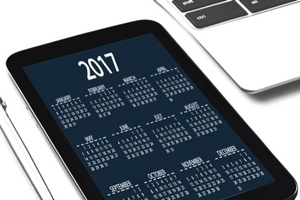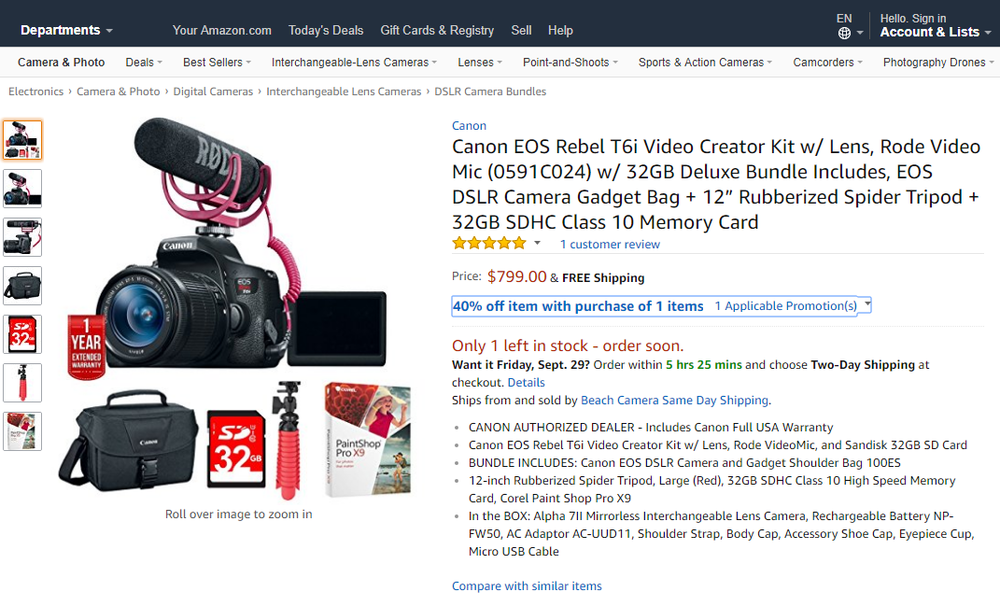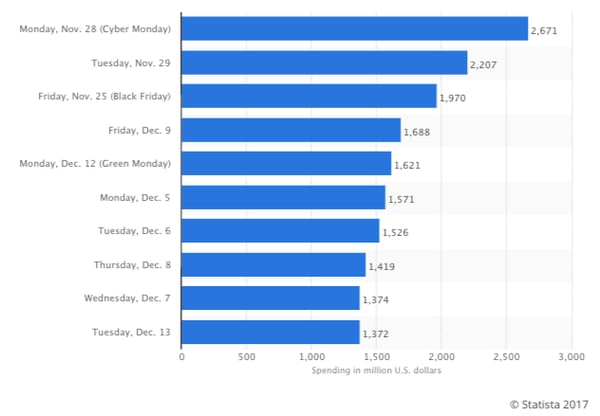There are three big days on the calendar for Amazon seller:s Cyber Monday, Black Friday, and Prime Day bring in more traffic, attract more customers, and potentially land more sales than any other days of the year. They are a huge opportunity for brands that prepare ahead of time, but getting ready for single-day sales events like these is somewhat different than preparing for the holiday rush in general. Let’s discuss how you can make the most of these opportunities.
Of course, Prime Day is one of the biggest days on the Amazon calendar, but don’t let that fact cause you to neglect your preparations when it comes to Black Friday and Cyber Monday. These two events are your point of entry into the holiday rush, so you need to make sure your performance lays a solid foundation for the rest of the season. With strong enough performance in the crucial days after Thanksgiving, you can build momentum that carries over into December and perhaps even all the way into January when recipients start spending their new gift cards.
To start with, let’s take a glance at the sheer scale of these massive selling days. We all know the holidays bring a rush of activity, but just how big is it?
Just look at the performance of those individual days in the graph above. If you plan ahead and do it right, Black Friday alone might give you reason to celebrate your own personal day of thanks-giving!
Black Friday began as a sales event for brick-and-mortar retailers, yet last year nearly $2 billion dollars was spent buying products online. It’s all but certain that online shoppers will spend even more on Black Friday this year—and on Cyber Monday, and the next week, and throughout the holiday rush. These are opportunities no seller can afford to ignore. But tapping into all this potential requires effort, forethought, and the ability to put best practices into action. Moreover, it requires knowledge, exactly the kind of knowledge the Bobsled team is ready to provide.
Supplying enough inventory
Let’s start with a quick review of best practices regarding inventory. We begin with inventory because all the product page optimization and advertising in the world can’t sell products you don’t have. If you run out of inventory, you can’t win the Buy Box and your PPC campaigns stop running. It may take weeks to recover from a stockout, and by then the holiday rush may have passed, meaning all your efforts for the big sales push were for nothing.
As a basic rule of thumb, you should have on hand a bare minimum of 150% of your average monthly volume during the holidays.If possible, consult data from the big sales events of the prior year and use those numbers to inform what you do now. For newer brands who don’t yet have this data, Prime Day data is often used as a proxy. Thinking through advertising spend and inventory levels with Prime Day in mind is an excellent way to prepare yourself for the big post-Thanksgiving sales events because it illustrates a similar massive, single-day spike in activity. In lieu of specific data on the late-November sales events, Prime Day data is the best planning tool you have.
The inventory game is simple: If you want demand, have enough supply. If your inventory level s aren’t adequate, or if you start thinking about inventory only two weeks before the demand hits, you’re in trouble. It’s best to allow yourself a buffer of at least a few weeks between when you order more inventory and when you expect it to be needed.
s aren’t adequate, or if you start thinking about inventory only two weeks before the demand hits, you’re in trouble. It’s best to allow yourself a buffer of at least a few weeks between when you order more inventory and when you expect it to be needed.
Don’t wait until the orders start coming in to order more. Be generous in your estimates of how long it will take for inventory to be delivered and processed. Leave lots of room to maneuver.
Optimize everything
Once you’ve anticipated the necessary levels of inventory, there’s almost certainly something you can do to update or optimize your product page listings. Optimization is important, and it’s something you have direct control over.
Here, your intention is to wring every last bit of benefit from organic traffic before you pay anything for advertising. Leveraging organic traffic first makes good business sense, but it will actually cause your PPC ads to perform better, too. The two are almost always connected. Without optimizing listings, keywords, titles, and product descriptions, you’ll have a harder time getting the most out of paid traffic later.
Look for alignment with the upcoming sales day. Titles should clearly reference it, while holiday-themed keywords should be mixed in with your usual highly-relevant keywords. It’s best to use the same keyword consistently—in the product, in the description, in the title, and, of course, in the actual keywords you’re targeting. If you’ve done some paid ads in the past, you’ll now be able to use the Search Term Report in your account to start off on the right foot.

The same is absolutely true of product images. If you can make a product seem like a natural fit for the approaching holiday, customers eager to get their shopping done will be far more likely to buy. Allowing plenty of time for testing will enable you to figure out which images offer the best performance before the rush of the actual sales events.
PPC
Pay-per-click advertising will be instrumental in reaching your goals for both of the big sales days in late November. In general, you will need higher budgets for your campaigns during this period. This may seem obvious, but it’s important to remember that all the other sellers on Amazon are also competing for sales during this busy time and, therefore, you’ll probably need higher bids in order to win. Again, consider your past Prime Day traffic and sales to get a feel for what Black Friday and Cyber Monday might look like.
Bobsled’s 25/25 Rule is a great place to establish a normal PPC spending benchmark. This rule has you aim for advertising costs to be 25% of your generated sales (an Advertising Cost of Sales, or ACoS, of 25%). That’s the first number. The goal with the second number is to have 25% of your sales coming from paid ads. As it relates to Black Friday and Cyber Monday, this rule is likely to hold steady at about the same levels, assuming organic and paid sales are growing at roughly the same pace.
Paid advertising is one area in which your general holiday preparation will differ from your approach to the single-day events following Thanksgiving. When it comes to Black Friday and Cyber Monday, you really should consider using Bid+.
Bid+ is how Amazon enables advertisers to raise their bids on ads up to 50% so they’ll be more likely to appear in the top row of search results. Enabling this function for weeks or months on end leading up to the pre-Christmas sales rush would be much too expensive for the majority of brands, but it’s okay to allow a jump in your ad costs for a brief period leading up to the big sales days. Turning on this feature in manual campaigns just for a select number of days during the holiday season could be very rewarding, especially for high-volume products with good profit margins.
Making the most of the ad types available to you is another tactic that could be very worthwhile for your brand. Vendors should consider using Sponsored Product ads, which generally appear below search results, and Product Display ads, which show up on the product pages of items related to those you’re selling. Another really great option is Headline Search ads in Seller Central. Until recently, these were only available to vendors using Amazon Marketing Services. However, now that they’re also available to sellers, it’s worth it to evaluate what the price of the bids might be and what your ad content would look like. If you’re operating in Seller Central, you may not have much historical data to work with for creating Headline Search ads, but doing so is probably still in your best interest. A successful strategy for late November sales days will likely include one or more of the ad types described above.
Whatever ad type you’re using, don’t forget to relate it to the holiday at hand whenever possible. Themed ads matching the upcoming sales events (or any related occasion) could be just what your products need to catch the attention of a consumer who needs that perfect holiday gift.
Deals and Promotions
Modified pricing is certainly something to consider for the big sales days of late November. Remember, it’s worth comparing these two big sales events to Prime Day because many of the same tips and techniques apply. Black Friday often conjures up images of great discounts and great deals for consumers, which means they’ll come to your product pages expecting to be wowed—and to get more for less. You should consider using discounts and coupons whenever appropriate. Bundling related products is also fast becoming a best practice, so consider which products complement each other or where you can tell a great story about how several products make sense together.

In Seller Central, Amazon may offer Lightning Deals more often in these busy days. The best practice here is to check frequently and think ahead about what your options are, so you’re ready to make a decision about the Lightning Deal when it comes along.
Wrapping it up
Keep in mind the global nature of e-commerce these days: A holiday sales bump can boost sales and traffic even in countries where the holiday at hand isn’t celebrated. For instance, Amazon’s British marketplace sees a big jump in sales around Black Friday despite the fact that the associated holiday, Thanksgiving, is an American event. For most online shoppers, a good sale in the U.S. is a good sale anywhere, regardless of why it’s happening.
The final five or six weeks of the year are a golden opportunity for brands who have prepared to hit the ground running in late November. Shoppers are already primed to purchase, and many of them will begin their shopping right on Amazon. You’re not trying to convince them to open their wallets; instead, you face the far easier task of getting them to buy from you instead of from someone else. Preparation can be a daunting task, but in the end, Black Friday and Cyber Monday represent enormous opportunities for brands to win business.
.png)


